Turning the meaningless into the meaningful
We record memories and keep mementos, often unconsciously, on a daily basis. We know the stories behind the photos and trinkets we keep, but to a stranger, our collection is meaningless.
For example, you may pick up a photo of yourself with friends, sitting around a table. You look fondly at the picture, chuckling to yourself, remembering all the events that occurred that night. But, let’s say your great-granddaughter picks up this same photo 40 years from now.What would she see?
Now imagine this same photo, but with the caption: ‘The gang, aged 25, the night Dan proposed to Jen’. Not only will your great-granddaughter laugh at what you’re all wearing, she now has context behind the image. This is not to say, however, that every trinket you keep needs its own accompanying novel. Having a record of who people are and your relationship with them, though, can turn something meaningless into something meaningful.
Why record memories?
There are lots of reasons why people want to record memories. Share them with friends and family or pass them through generations. There are lots of different methods to collect these stories. Interviews and asking questions, for example, are a great way to inspire memories. For more interview ideas read our post on: ‘Questions to Inspire Memories and Life Stories’. In this article, however, we will focus on how to inspire memories using visual cues through mementos and artifacts.
Not only is collating all your photos and mementos a nice way to stay organised but when it comes to getting a biography written it’s also really convenient too. Professional biographer, Andrew Crofts, explains that in his experience: “The more material (clients) have, the better unless there is so much that you feel overwhelmed, in which case put it aside for later.”
Collecting Memories
So what exactly should you be collecting? Well, we’ve comprised a short list of mementos that could be really useful in inspiring memories and stories, and that you may have otherwise overlooked if asked to recount a life story outright.
Photographs and Films
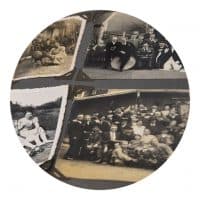
Photographs and films are probably the most obvious visual cues for recalling memories. They literally capture the image of the person or event. A photograph may serve as the most direct method of showing what someone or something looked like. However, this doesn’t mean the picture alone conveys the whole story, or how you experienced it. Much like any other memento, the significance of a photograph is subjective, as is the story that the image inspires. Photos can also be preserved by including them in a biography book.
Andrew Crofts explains the role of the photograph when preparing for a biography:
“Photos can enliven the text but they need to be interesting, not just views. They need to feature the people who will be appearing in the story, maybe their houses if that will help to paint a picture.”
Rachel LaCour Niesen, keen photograph preservationist gives us an insight into why she is so passionate about photography, as well as ideas on how to display photographs:
“In the age of social media and instant gratification, I think families are hungry for tangible experiences. There’s magic in holding printed photos in your hands, in passing them around the table. That’s because analogue photos trigger powerful emotional responses. Most families have hundreds of analogue photos in their homes. These photos hold valuable family memories; they are passports to a place called memory. We must make an effort to rescue them from deterioration and loss. When analogue photos are in danger, family history is also in danger.”
“National Endowment for the Humanities Chairman William Adams says: “We know that America’s cultural heritage isn’t found only in libraries and museums, but in our homes, in our family histories, and the stories and objects we pass down to our children.”
“Indeed, photographs are a living, breathing archive. They are meant to be displayed and shared. Whether they’re displayed in frames, in an old-school slideshow, or in albums, I hope all families recognise the value of their personal photographic histories. Can you imagine never having the magical experience of discovering a box of family photos? It’s like finding buried treasure! I would love to guarantee that experiences like that aren’t lost in the future. Somehow, I can’t imagine sorting through old hard drives to be quite as magical as opening up a shoebox of printed photos.”
For more ideas and advice on how to preserve old photographs visit Rachel’s site: SaveFamilyPhotos.com
Diaries and Letters
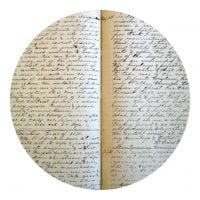
Diaries and letters serve as powerfully written cues for recalling memories. Letters can reveal a great many things, from sharing big news to revealing secret love affairs. Meanwhile, diaries are a personal way of recording your thoughts and feelings whilst they’re still fresh, as it is often harder to remember in hindsight.
In an interview conducted by the National Diary Archives with diary collector Sally Macnamara, the significance of the written word is truly realised. Sally, who specialises in collecting and selling these personal hand-written records, gives us an insight into why this became her passion:
“The most important thing I would say is that real life is so much more exciting and rewarding to read about than any story anyone could make up. And that no matter who you are, every life, every true story, has fascinating aspects to it, and that we all have a story to tell. So many people think they have nothing to share, nothing to teach, nothing that’s worthwhile in their life, but that is so untrue.”
For more inspiration on collecting diaries and to follow some truly amazing diary stories visit Sally’s Diaries.
Newspaper Clippings
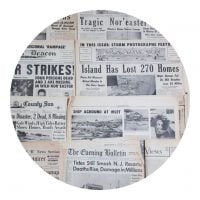
Saving newspaper and magazine clippings of significant stories is another great way to preserve memories. Many of us rely on cues to jog our memories. Therefore, keeping a record of important news stories is a great way to remind us what we were doing at the time of the event or at the point of reading the story.
Additionally, keep meaningful magazine clippings and display them in a frame or in a book. This is a really meaningful way to keep a record. Preserving clippings in this way can also be a great way of presenting an album of events that occurred throughout your life, quickly and with little effort.
Mementos
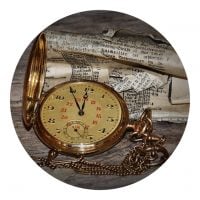
The beauty of collecting mementos is that they can be anything. Keeping a box of objects you’ve collected over the years serves as a treasure trove for your grandchildren. It will probably bring about some nostalgia within your future self, too.
The objects do not need to be valuable or even attractive. It’s all about keeping items that will remind you of a special time. Keeping a ticket stub may be all you need to remember one of the best weekends of your life.
The box itself could also be something significant. Just as all the objects inside are specific and special to you, so the container could be too. Some people may keep their trinkets in their favourite biscuit box. Others may appropriate an old shoe box and collage it with stamps they’ve collected. Whatever it may look like, everyone should have a box that inspires memories.
There is no specific time to start to record memories. However, the sooner you start, the more memories you’ll preserve and the more you’ll have to share with future generations. It’ll also make the process of writing your own memoir or having a biography written much simpler when you come to it.
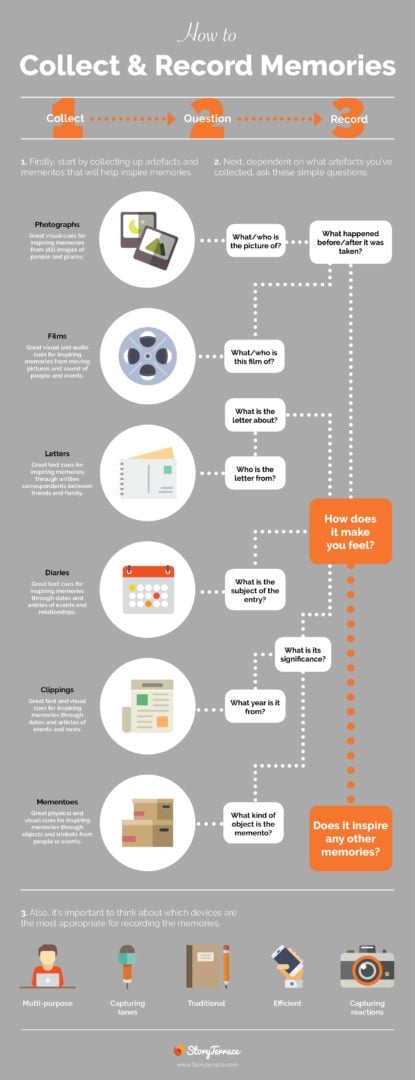
Written by Amber Hicks


